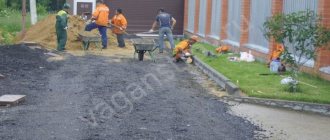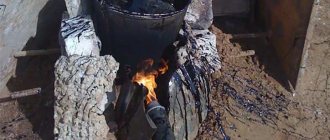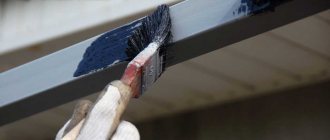Even now, many people build houses from logs or timber. But the tree is susceptible to rot and fungal diseases. Therefore, there is a need to replace the lower crown. And in this article we will talk about how to lift a house with a jack with your own hands. You will learn what the technology is for this type of work, how to determine by external signs whether a log house needs repairs, and why it is important to be well prepared for raising a house. At the end of the article you will find information about common mistakes and a video on how to pour a foundation for a raised frame.
A wooden house needs to be raised periodically to carry out repairs Source sv-mosfundament.ru
What houses can be raised and why do it?
A feature of the operation of any wooden building is the need to replace the lower crowns. After some time, they simply fail due to rotting. Also, information on how to raise a house with your own hands using a jack will be useful to those who are planning to repair the foundation.
For major repairs, only one-story buildings made of timber or rounded logs, as well as panel buildings, can be lifted with a jack.
Correct and timely repairs are very important, because a building made of hard wood, such as oak or larch, can last up to a hundred years. Even now, wooden houses from pre-revolutionary buildings have been preserved. However, to achieve this longevity, the lower crowns need to be replaced approximately every 15-20 years.
A wooden house with timely repairs can last a very long time Source i.pinimg.com
Modern wooden buildings are not so durable, because due to environmental deterioration, timber is now more susceptible to rotting.
Restoration of the lower crown
If the lower crown of the wall was removed due to dilapidation, do not forget to restore this belt. To do this you will need a prepared log or timber. We lay them on a new base.
We cut out the places where the jacks are installed; after removing them, the missing parts will be inserted into place. But if the lifts are only in the corners, then there will be no problems. We carefully insulate the gaps between the beams with caulk, flax-jute or padding polyester.
Now we lower the jacks at the same speed as we raised them - 2 cm from each corner. After removing the mechanisms, if necessary, insert the sawn parts of the first tier, insulate and close all the holes.
External signs of problems
There are several signs that indicate it is time to repair the lower part of the building. It's easy to spot them. This may include:
- Violation of the foundation of the house
- Deepening the foundation into the ground
- Subsidence of the building in the corners
- Severe distortion of windows and doors
- House tilt
If you notice such signs, then you should think about how to raise a wooden house with a jack. But first you need to decide what type of repair work needs to be done. In addition to replacing rotten crowns, you can resort to compacting the foundation and even replacing it completely or partially.
In this case, you will definitely have to change the entire bottom row Source vosaduly.ru
In addition to repair work, after raising the house with a jack, you can carry out prevention by treating the wood against rot and fungus with various chemical compounds.
Preparatory work
There may be several reasons why a house should be raised to a certain height: destruction of the foundation, constant dampness of the base or an increase in its size, as well as replacement of the lower crowns of the house. To perform this work, you will need empty space between the building and the foundation. But first the house must be prepared.
List of mandatory actions before raising a building:
- simplify the structure as much as possible - remove furniture and things;
- disconnect the building from utilities - water supply, sewerage, gas and electricity;
- make sure that the lifting of the building will not be hampered by foreign objects - tree branches, power line wires, etc.
After this, you can begin the main stage of work.
Which jack to choose to lift a house
When choosing a jack, first of all you need to pay attention to such a parameter as its power or lifting force. To calculate the required value of this value, calculate the mass of the house and then divide it by 4. However, when lifting a small building, it is advisable to choose jacks with a lifting force equal to half the mass. The fact is that when lifting large houses, up to ten installation points for the lift are created, and when lifting small ones - only 4.
To raise a house, it is better to place as many supports as possible Source oldhousecrazy.com
Before you lift a house with a jack, you need to decide on the type of mechanism. For houses located low above the ground, rolling and inflatable devices are well suited. Before installation, a board 50-100 mm thick is placed under them. If the distance from the lower crown to the ground is 30-40 cm, then it is better to use bottle or scissor hydraulic jacks.
See also: Catalog of wooden house projects
Precautionary measures
In order to properly raise a house without causing damage to the structure itself and the people carrying out the manipulations, it is necessary to analyze a number of factors.
- Mass of the building. Each jack must provide 40% of the total lifting capacity. To do this, it is necessary to calculate the total weight of the building: the cubic capacity of the box is multiplied by the specific gravity of the wood (it is equal to 0.8 t/m3), and the weight of the roofing and finishing is added to the resulting value.
- Box dimensions. If the length of the structure exceeds 6 m, there is a high probability of logs and beams sagging at the junction, then additional installation of supporting elements in the areas where they are joined may be necessary.
- Features of internal cladding. If plaster or plasterboard sheets were used for interior decoration of walls and rooms, this can significantly complicate the implementation of all necessary work. In order to avoid repeated renovation of the interior, it is necessary to additionally install 50 cm thick boards on the outside - they are placed in the corners.
- Soil features. Depending on the type and structure of the soil on which the jack is fixed, it may be necessary to use concrete blocks of increased area. This way you can protect the lifting mechanism from diving.
- Lifting height. Typically, the length of the working stroke is limited by the design features of the lift itself. The use of special pads made of durable timber with a rectangular cross-section will allow you to achieve the required moving height.
- Repair work should be carried out without haste. The total duration of lifting and returning a house using a jack is determined by the level of difficulty. Sometimes the work takes longer - in this case, it is extremely undesirable to support the structure on racks; it is best to use temporary metal or wooden structures that have a sufficiently large supporting platform.
Watch the following video for the process of raising a house with a jack.
Raising a house with a jack
Before you jack up the house with your own hands to change the bottom row, you need to do some preparatory work.
Disabling communications
First you need to turn off all communications leading to the building. This could be an electrical network, gas, water supply, sewerage. In addition, it is necessary to cut or disconnect all other pipes connecting the house to the ground, because they can greatly interfere with the rise of the log house. If you ignore this step, you can cause serious damage to your home.
Don't forget to turn off the power before jacking up the house Source sense-life.com
The stove requires special attention, because it stands on an autonomous foundation. Therefore, when lifting a house with a jack, you need to ensure free movement of the chimney through the roof.
If the boiler is on the floor, then all hoses and connections must be disconnected from it. If it hangs on the wall, it will not interfere with the work.
Preparing to install the jack
The method of installing the jack depends primarily on the type of foundation. It is necessary to cut rectangular niches on strip and slab bases. Wooden panels are laid on columnar or pile foundations to install the jack.
The place to install the support must be smooth and level. A special metal tripod stand will be placed on it, which in no case should slip. It is needed for height adjustment.
You should definitely get stable and durable jack stands Source ad-cd.net
See also: Catalog of companies that specialize in foundation repair
Also, wooden plates will be required for the work. It is advisable that their width be at least 20 cm.
If a complete replacement of the foundation is planned, metal corners and channels will be needed, from which temporary support can be welded until the new foundation acquires the required strength.
Technology for lifting a house with a jack
Now directly about how to raise a wooden house in order to place a foundation under it. There is a certain procedure and some rules that must be followed during the lifting of the building.
So it’s better to start work in the morning, so that by the evening you have time to completely finish the lifting and set up all the necessary supports. First of all, it is worth raising the most sagging part of the building.
First you need to figure out how to raise one of the corners of a wooden house with your own hands. At a distance of about a meter from the corner, they dig a hole to install the first jack and make a special flooring in it. Then a lift is installed in this hole and brought under the lower crown, placing a steel plate. But if the log is completely rotten, then you will have to cut a notch to denser layers, into which the jack pin will be inserted.
A jack for lifting a log house is installed in a special hole under the lower crown Source i.ytimg.com
Then proceed directly to raising the angle. This must be done carefully. The lifting height at a time should not exceed 5-6 cm, after which it is necessary to wedge spacers. At the same time, you need to inspect the building around the perimeter for any unexpected deformations.
After one corner is raised by 5-6 cm, you need to start the same procedure on the second corner of the same wall. Next, a third jack is installed in the middle of the lower crown using the same technology and the center is raised.
Now the entire described operation can be carried out on other walls. After the entire perimeter of the house has been brought to the same height, it is worth evenly continuing the rise to the required level. At the end of all work, the jacks can be removed and replaced with supports. There should be quite a lot of them so that there is not too much pressure on certain points of the log house.
You need to put supports under the raised frame Source ros-k7.ru
Dismantling the old base and installing a new one
Replacing Lower Timbers and Repairing the Foundation
After raising an old house, it may be necessary to replace not only the crowns, but also the foundation. The old frame is disassembled using a jackhammer, hammer drill, crowbar, or sledgehammer. To dismantle a powerful foundation, construction equipment will be required. The waste generated by raising the house and replacing the foundation is left behind. They will come in handy when pouring a new foundation.
Features of dismantling different types of foundation:
- Dismantling of the belt begins with an assessment of the complexity and volume of work. A small one can be disassembled with a handy tool. For fittings you should use a grinder. Large structures require special mechanisms and equipment.
- Dismantling a precast concrete base is not particularly difficult. The joints between the blocks are broken off with a jackhammer. The mounting loops are brought to a vertical position. Using construction equipment, FBS blocks are pulled out, loaded onto a vehicle, and taken away. Reinforced concrete blocks are a durable material. It is possible to reuse them at less critical facilities.
- The top of the destroyed pile base is cut off. If the damage is severe, reinstallation will be required.
- The monolithic slab is destroyed in the same way as the strip base. If necessary, part of the base is used or expanded to change the area.
- Other types of bases - rubble, columnar, can be disassembled with improvised tools using an angle grinder, a jackhammer, a sledgehammer.
- The destroyed screw foundation is cut to a whole part and built up with a metal pipe.
It is natural that dismantling work is the most labor-intensive. They require responsible decisions and compliance with safety standards.
You can dismantle the foundation using hand tools or an excavator.
Methods for destroying the foundation:
- hand tools;
- excavator, heavy equipment;
- chemicals;
- explosion;
- ultrasound;
- hydrocline.
In private housing construction, the first 2 methods are most often used. When dismantling, the main thing is to correctly calculate your strength. In some cases, hiring a professional team is more profitable than doing it yourself.
Stages of installing a new foundation:
- After removing the foundation, a trench is formed for a new support. When the old foundation is deep, the sand cushion is renewed - it is added, spilled with water, and compacted. In the case of a shallow foundation, the trench is deepened by 20 cm and a shock-absorbing cushion is also added.
- Removable or permanent formwork is installed in the trench. Places for installing jacks are bypassed. Subsequently, the technological holes are filled with bricks.
- Waterproofing and a reinforcing belt are placed in the formwork. The lattice in it is welded or knitted with wire. The edges of the reinforcement must be spaced at least 50 mm from the outer layer of the foundation to prevent premature corrosion.
- In the corners, the reinforcement cage should be bent and not welded. These are the most stressed parts of the foundation.
- The prepared formwork is poured with concrete in 1 time or at least 1 shift.
- After the concrete has hardened, the logs are replaced. Using the tapping method, rotten areas are identified and cut down. Logs are replaced until they are well preserved.
When installing, be sure to use hydro-thermal insulation. This will extend the life of the walls and foundation. With good care, the log house will last another 30-40 years before repair.
How to avoid common mistakes
When lifting a house with a jack, the following mistakes are most often made:
- They forget to disconnect the last crown from the foundation
- They raise one wall of the house too much
- The jack is installed unsteadily and shaky
- Do not place plates between the mechanism and the crown
- Using supports that are too thin and narrow
If, when lifting the house, you notice late that you forgot to disconnect the frame crown, then you will have to caulk the entire frame, because lifting the logs will pull the arches away from each other.
Some mistakes can lead to the fact that the log house will have to be re-caulked Source images.ru.prom.st
If you lift up one wall too much, the windows and doors may jam. Also, the beams can warp, which is why the entire building will have to be caulked. Poor installation of the jack can lead to it sagging or slipping out from under the crown.
Types of foundation deformation
In addition to finding out the reasons that led to the destruction of the foundation, it is necessary to give an adequate assessment of its extent. This will allow us to determine the possibility of strengthening the foundation and the feasibility of this event. Maintainability is determined in accordance with the following criteria:
1. Damage is minor
This includes violating the integrity of the foundation finishing. The presence of phenomena of this kind does not affect the strength of the foundation and does not reduce its bearing capacity. Eliminating them is easy.
2. The damage is moderate
The occurrence of cracks is associated with the process of subsidence or destruction of the base. Before starting work, it is necessary to differentiate the nature of the cracks. Their horizontal arrangement poses less danger compared to vertical or zigzag
In addition, it is important to find out what the nature of the process of foundation subsidence is. That is, this phenomenon is temporary or progressive. Average damage
To clarify this circumstance, beacons are used. Plain paper can be used as them, but there is a risk of it getting wet. The use of plaster plasters is recommended. The simplest method involves applying a small amount of putty to the surface. Then, using a spatula, a mark is made in the form of a straight line. Even a slight shift of the tested surface will be noticed. In addition, when using this method, you can find out at what speed the destruction process occurs.
Temporary subsidence will not be detected by beacons. In this case, most likely, some shift of the soil located under the foundation occurred, it was fixed in a certain position and the probability of further movement is low. Therefore, to eliminate defects, it is sufficient to carry out routine repairs.
When lighthouses are destroyed, it can be argued that the destruction process is progressing. Sealing cracks will not give the required effect, since the deformation is close to catastrophic.
3. The damage is catastrophic.
The presence of defects of this kind can cause destruction of the structure. Timely work to strengthen the foundation will prevent extremely negative consequences from occurring. However, in practice there are situations in which this opportunity is missed.
The choice of technology depends on the type of foundation. In this case, each specific case considers its strengthening or replacement.
4. It is not possible to eliminate deformations
The condition of the foundation is so poor that repairs are impractical. In such situations, the most correct solution is to demolish the building. From an economic point of view, dismantling a house is much cheaper and simpler than measures to strengthen the foundation. The construction of a new cottage on the site of the previous one in accordance with building codes and regulations will allow you to have comfortable and safe housing.
Second lifting technique
Preparatory work involves choosing a method of carrying out the work. There is another technique that involves simultaneous synchronous work from all sides. Jacks are installed along long walls; about 60 cm should be moved inward from the corners.
If the crown logs are worn out and the wall length is more than 4 m, additional jacks can be placed in the middle of the walls. The work is carried out synchronously, and the log house is raised by 3 cm in one go. Each stage of lifting must be supported by support beams or pillars. This method is effective and not so traumatic for the craftsmen and the log house.
Lifting methods
Preparatory work involves choosing a method of carrying out the work. You can use more than just jacks to pour a new foundation. This method is effective and takes more time, but unlike lifting with a crane it causes less damage to the building. The building can be lifted in stages from each side or from all sides simultaneously. If there is only one jack, and its lifting power corresponds to the weight of the building, then the building can be lifted a little from each side.
To do this, the device is located at a certain point in the house, and the building is raised by 3 cm. It is necessary to place a support under the resulting space and move it to another place. This will allow the building to be raised to the required height. This method is dangerous, since if the height changes, the walls may not bear the load and collapse. A height difference of 2 cm in the crown area will be equal to 6 cm at the level of the ridge.
Reconstruction stages
Remodeling an old home may involve some or all of the following steps. First, you will have to replace the foundation completely or partially. Sometimes it is strengthened by eliminating cracks and strengthening the base part. If the walls become rotten over time, then the defective logs or beams are replaced with new ones, which especially applies to the lower crown. Fragments of walls can be completely replaced.
The roof is usually a problem area in old houses, so it is restored by replacing the rafters and roofing. Reconstruction of an old house also includes partial repairs or replacement of the floor. Communications during reconstruction also change partially or completely, this should include electrical wiring and pipes.
Features of building renovation
It will be necessary to install a new drainage system, since over many years of operation it will inevitably need it. And the pipes are probably already technically outdated. Doors and windows are required to be replaced. When renovating a house, wooden elements are impregnated with protective compounds such as fire retardants and antiseptics. Walls can be insulated outside and inside. This also applies to the roof and floor. At the final stage, the outer surface of the walls can be restored, sanded, coated with a primer and impregnated with an antiseptic. Then the surface is covered with paint or varnish.
Preparing for the climb
Before you begin to raise the building, several preparatory steps are performed:
- They hammer in 2 slats at each corner of the building, marking the height of the wooden house on them using a hydraulic or laser level.
- Furniture, household appliances and other large objects that can increase the overall weight of the structure and be damaged during lifting are taken outside the building.
- They reduce the weight of the building by dismantling the floor covering - a mandatory step if there is a stove in the house, which also requires the removal of the sheathing and roofing around the chimney.
- Prepare the walls, which are recommended to be strengthened using boards attached perpendicular to the plane of the enclosing structures.
- Door and window blocks are dismantled, protecting them from deformation.
It is not necessary to prepare the walls of a frame building, but it is advisable. The result of strengthening is the prevention of the appearance of cracks, deformation of structures and distortion of the entire frame as a whole.











